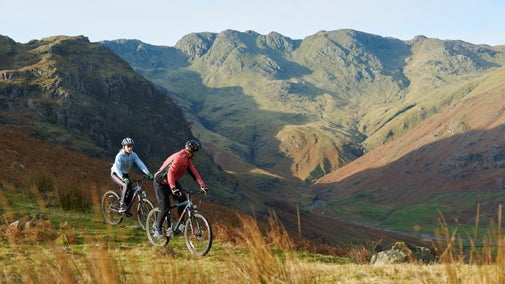
Discover more in the Lake District
Home of Beatrix Potter, dramatic landscapes and fascinating history.

There’s a long tradition of wild camping in the Lake District but there's a difference between true wild camping and illegal fly camping. Please read these guidelines carefully to help you decide whether wild camping is right for you or whether an established campsite would be a better option.
The most responsible way to camp is to stay at a recognised campsite. There are a number of 'wild' campsites across the Lake District with lakeshore access and mountain views. The National Trust looks after four such campsites which can be found in the Great Langdale valley, on Windermere's lakeshore at Low Wray, in Wasdale and another in Eskdale, offering amazing locations and perfect bases for exploring the great outdoors. The experience at these campsites is on a par with the wildest of campsites. They offer comfort and practicality whilst reducing the impact on the environment through the established facilities you'll need during your stay, such as toilets, bins and running water.
Stay out of sight and for only one night
A wild camp pitch must be above the highest fell wall (approximately 400m or 1200 feet high) and shouldn't be noticed by anybody else. This means staying away from any buildings or other wild campers. Don't camp next to streams or springs to avoid contaminating the water. Arrive late in the day (dusk) and move on at dawn.
Keep your group small and be prepared to change your plans
Wild camping locations are well away from towns, villages and lakeshores and are completely inconspicuous. If there are two tents already in your spot, you'll need to move on – these special places cannot sustain large numbers of campers.
If your planned pitch is not above the highest fell wall this is illegal fly camping - not wild camping. The only places you can camp in valleys, by lakeshores or in lowland areas are on official campsites.

Travel light
A well prepared backpack should contain enough equipment for a basic overnight stay. If this isn’t enough and you need more stuff, that’s an indication an official campsite will be a better option. Use a small and lightweight tent that blends into the landscape – part of the enjoyment really is experiencing unspoilt landscapes.
Don't light fires or BBQs
We all need to play our part in protecting this precious environment. Fires can cause a lot of damage and risk starting uncontrollable wild fires. The right equipment, and stoking up on good camp food warmed on a lightweight camping stove, is the way to keep toasty.
Be a champion of ‘Leave no trace’
Look after the Lake District you love by leaving no trace at all. This includes litter and all human waste. If you need a bin or a toilet, this kind of camping isn’t for you.

Part of the fun of wild camping is finding your own route and spot for the night using your navigation skills. Planning and preparation is essential, including checking the weather, having the right equipment and being confident you have the skills and experience to safely spend a night away from civilisation. You must be able to look after yourself and your group in remote locations.
Visit Adventure Smart for more tips on how to keep yourself and others safe in the Lakes.
Please follow the Countryside Code when you visit the Lake District. By taking your litter home with you, keeping your dog under control, keeping gates, driveways and roads clear and sticking to designated footpaths, you can help us care for the Lake District and the wildlife and people who call it home.

Home of Beatrix Potter, dramatic landscapes and fascinating history.

A UNESCO World Heritage Site, there's so much to explore on a holiday in the Lake District. Discover craggy fells, wildflower-rich meadows, traditional sheep farms and crystal-clear lakes. We have a wide range of accommodation across the Lake District, from lakeside cottages to rustic bothies and campsites for you to browse and plan your stay.

Get the best out of your visit by planning ahead. From finding a car park and checking capacity, to following the countryside code and preparing for your outdoor adventure safely, we've pulled together the tools, tips and guidance to help you make the most out of your trip and help us look after the Lake District.

Explore the Lake District's majestic mountains – among them Scafell Pike, the tallest in England – ancient woodland, hidden waterfalls, rugged coastline and, of course, its many lakes. You might even spot a red squirrel, roe deer or bird of prey.

From gentle ambles to more challenging hikes, these are some of the best walks to explore the heart of the Lake District.

Discover what the Lake District has to offer if you love getting outside – from walking and cycling trails for all abilities, canoeing and sailing, to relaxing pleasure boat rides.